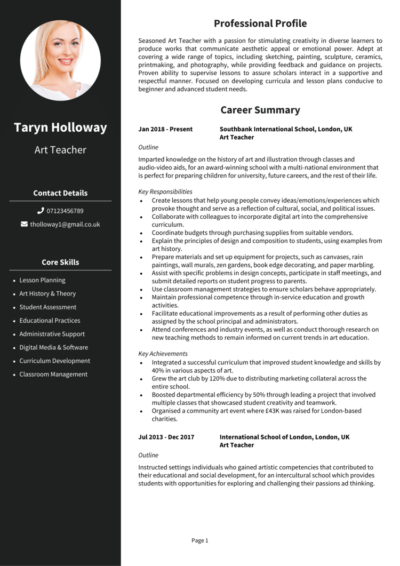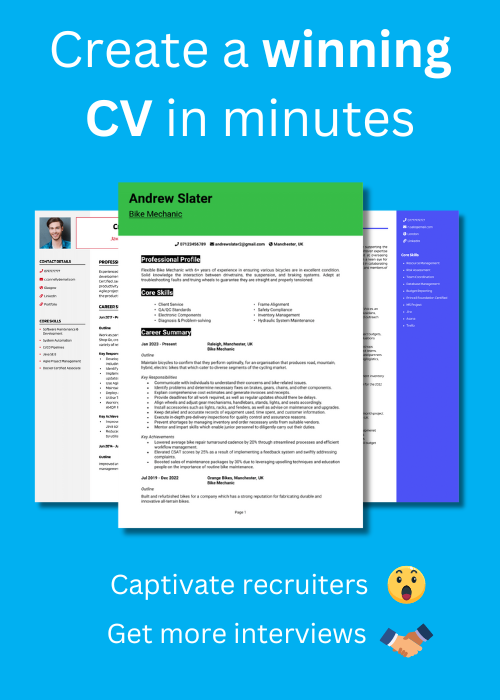Turning a blank canvas into art is your specialty: that’s just what you’ll need to do to put together your new CV.
This guide gives you a clear plan to work from – no abstract concepts or vague outlines, just step-by-step advice and an Art Teacher CV example to help you present your expertise.
Art Teacher CV
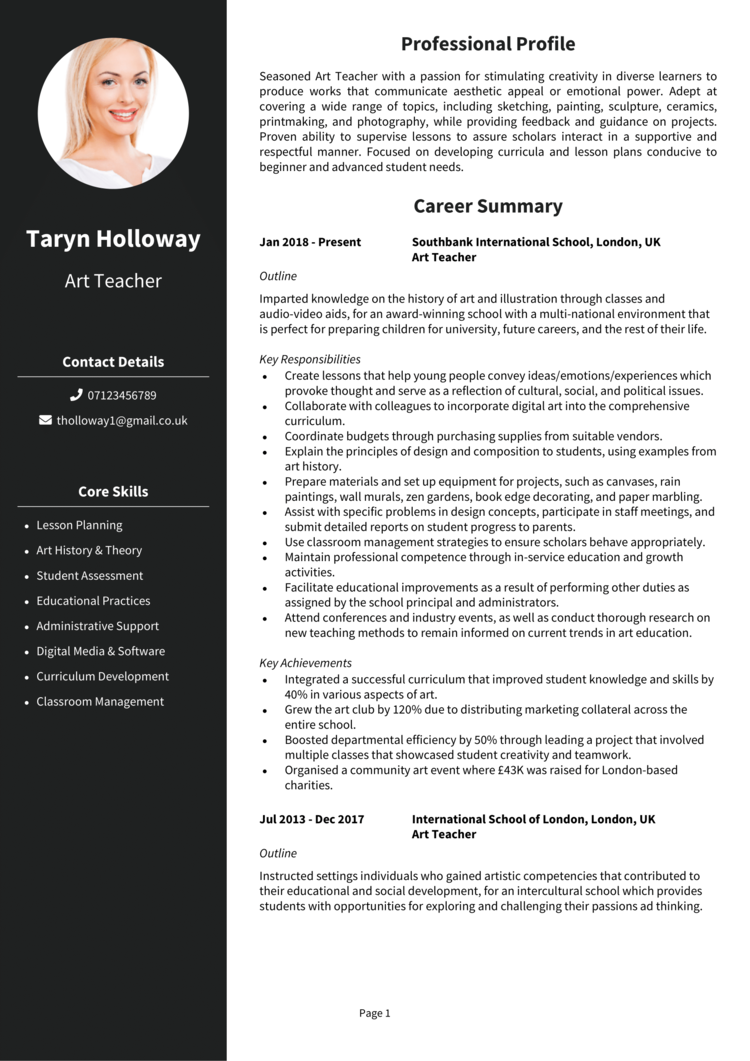
How to write your Art Teacher CV
Discover how to craft a winning Art Teacher CV that lands interviews with this simple step-by-step guide.
Whether you’re leading a secondary school department or guiding primary pupils through their first brush strokes, the way you present your experience matters just as much as the experience itself.
This guide walks you through every section, helping you organise your artistic journey into writing a CV that’s as engaging as it is effective.
Structuring and formatting your Art Teacher CV
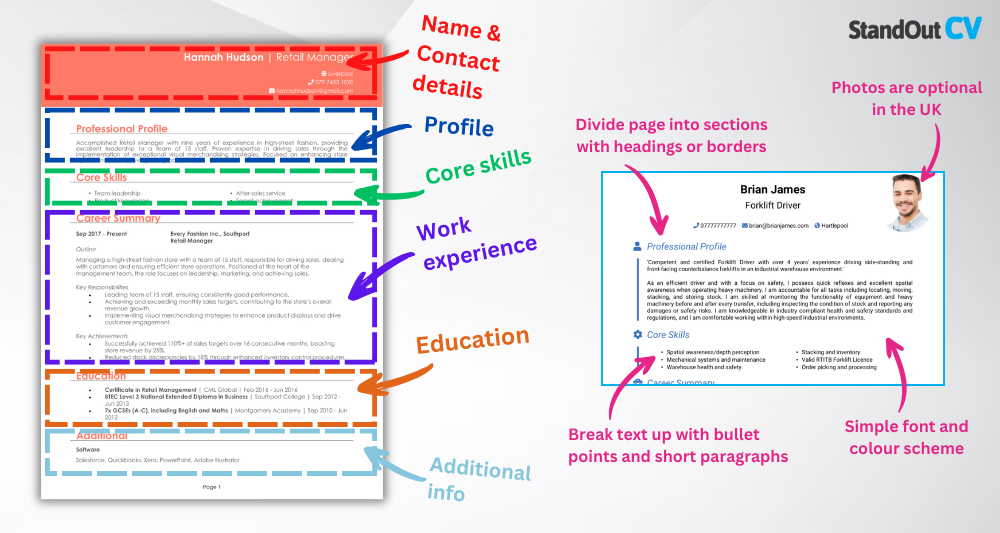
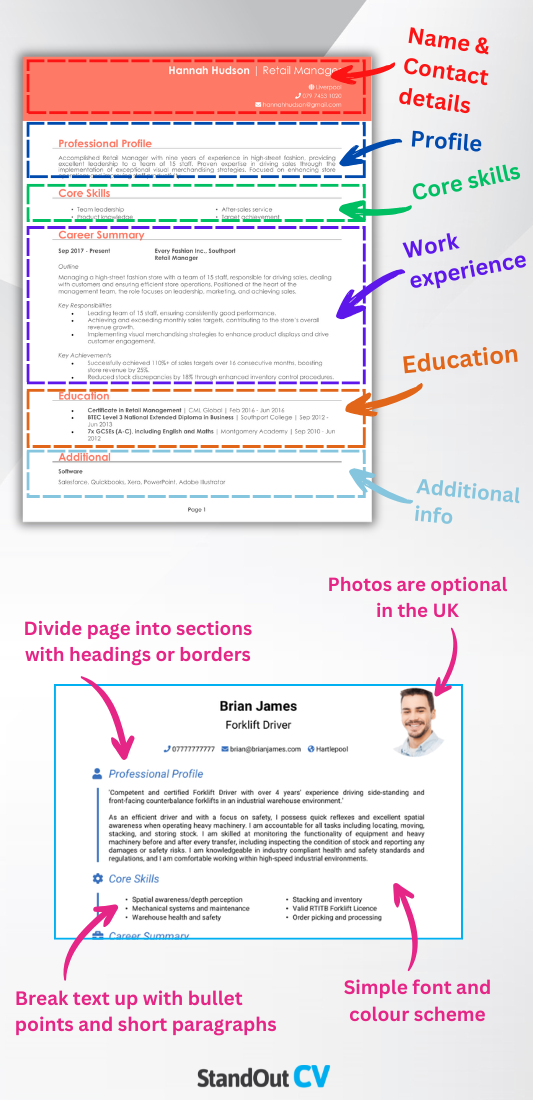
In a creative field like art education, it’s tempting to let your design skills shine through – but the CV structure itself should stay clean and easy to navigate. You can save the flair for your portfolio: your priority here is making your application as pleasant and simple to read as possible, so no recruiters struggle to understand what makes you the perfect fit.
Here’s the layout to follow:
- Name and contact details – Place these personal details at the top so employers can get in touch easily.
- Profile – Kick things off with a concise overview of what makes you the ideal candidate for the job.
- Core skills – Briefly highlight those qualities which make you the best candidate.
- Work experience – List your previous roles in reverse chronological order, with your most recent first.
- Education – Go through the academic history which underpins your expertise.
- Additional info – This optional section can include professional memberships, awards, or hobbies that showcase your suitability for the role.
Keep your font legible and classic, and divide your CV with clear, bold headings. Bullet points are your friend in the experience section – they break up dense information and help recruiters quickly spot what they’re looking for. Limit your CV to two pages long, use plenty of white space, and don’t overcrowd it with long paragraphs or visual distractions. A clean format shows that you can bring order to creative chaos – something every head of department values!
The best way to write an Art Teacher CV profile


This section is your opportunity to present yourself as a confident, capable educator with a passion for visual learning. It’s a short paragraph – just a few lines – but it’s the first thing recruiters will see, so make sure it captures your professional identity and the value you bring to the classroom.
Rather than listing every artistic medium you’ve ever taught, focus your CV profile on how you teach, the kind of learning environment you create, and the results you’ve helped students achieve.
Art Teacher CV profile examples
Profile 1
Creative Art Teacher with over 10 years of experience teaching Key Stages 3–5 in secondary schools and sixth form colleges. Skilled in delivering engaging lessons across a range of media, including painting, printmaking, and digital art. Committed to fostering creativity, critical thinking, and personal expression in every learner.
Profile 2
Passionate Art Teacher with seven years of experience in both classroom teaching and extracurricular art programmes. Experienced in developing inclusive schemes of work and preparing students for GCSE and A-level exams. Known for maintaining a supportive and inspiring learning environment where students thrive artistically and academically.
Profile 3
Motivated Art and Design Teacher with five years of experience delivering the national curriculum and BTEC qualifications in diverse school settings. Strong background in mixed media, assessment moderation, and community art projects. Dedicated to nurturing each student’s individual artistic voice.
Details to put in your Art Teacher CV profile
Here are some tips on what to include:
- Where you worked – State the level and type of educational institutions you’ve worked in – from secondary schools to sixth forms or specialist academies.
- Your top qualifications – Include your degree, teaching qualification, and any subject-specific training.
- Essential skills – Highlight your ability to plan engaging lessons, encourage creative confidence, and support different learning needs.
- Your artistic focus – Mention the styles, media, or disciplines you’ve taught, from traditional techniques to digital tools.
- Value delivered – Emphasise how your teaching has helped students express themselves, improve their skills, or succeed in exams or applications.
How to present your core skills section properly


The core CV skills section provides a snapshot of your teaching and creative strengths – giving hiring managers a quick idea of what you bring to their department. While you don’t need to list every technique or tool, focus on key professional capabilities that are aligned with the specific role you’re applying for.
This section should reflect your ability to deliver excellent teaching, maintain classroom engagement, and contribute to the wider school community. Keep it aligned to the job description, and always prioritise tangible, well-defined strengths over vague or general traits.
Key skills that make an Art Teacher CV stand out
- Curriculum Planning and Development – Designing engaging art programmes that align with educational standards and support student creativity.
- Drawing and Painting Instruction – Teaching techniques in mediums such as pencil, ink, watercolour, and acrylic to develop artistic skills.
- 3D Art and Sculpture Techniques – Guiding students in working with materials like clay, paper mâché, or mixed media for three-dimensional projects.
- Art History and Theory Integration – Introducing students to key movements, artists, and cultural contexts to deepen artistic understanding.
- Classroom Management and Student Engagement – Creating a positive, organised learning environment that encourages participation and self-expression.
- Assessment and Feedback – Evaluating student work and progress, providing constructive feedback to support artistic growth.
- Exhibition Planning and Display – Organising school art shows and curating displays that showcase student work professionally.
- Digital Art Tools and Techniques – Teaching digital illustration, photo editing, or animation using software like Adobe Photoshop or Procreate.
- Adaptation for Diverse Learning Needs – Modifying lessons and materials to accommodate students with different abilities or learning styles.
- Resource and Material Management – Maintaining classroom supplies, budgeting for art materials, and ensuring tools are safe and ready for use.
How to present your work experience in your CV


Your work experience section should go beyond listing what you taught – it’s where you show how you made an impact. Whether you introduced a new curriculum module or raised pupil attainment, this section should communicate both your responsibilities and your on-the-job achievements.
List your jobs in reverse order, starting with the most recent. Open each one with a short paragraph describing the school, your teaching level, and your subject remit. Then follow with bullet points that show your contributions and results – especially anything tied to pupil outcomes or extracurricular activities.
How should you list jobs on your Art Teacher CV?

- Outline – Summarise the school setting, the age groups you taught, and your role within the department. Mention if you held responsibilities like form tutor, mentor, or curriculum lead.
- Responsibilities – Use action words like “delivered” and “developed.” For example: “delivered GCSE coursework support to Year 11 pupils” or “developed inclusive schemes of work for KS3 art lessons.”
- Achievements – Include any standout contributions. Did your students win competitions? Improve their grades? Curate an end-of-year exhibition? Numbers and outcomes give weight to your experience.
Work history examples for Art Teachers
Art Teacher | Willowgrove Secondary School
Outline
Taught Art and Design across KS3 and GCSE levels for a comprehensive school with a strong focus on the creative arts.
Responsibilities
- Planned and delivered practical lessons across drawing, sculpture, and print techniques
- Prepared students for AQA GCSE Art assessments, including portfolios and final pieces
- Organised classroom displays and exhibitions of student work
- Led extracurricular clubs including sketching and set design
- Worked closely with SEN staff to support students with additional needs
Achievements
- Improved GCSE pass rate by 17% in two academic years
- Curated an end-of-year art showcase attended by over 200 parents and community members
- Supported two students in securing places at national art foundation programmes
Art and Design Teacher | Elmhurst Academy Trust
Outline
Delivered Art and Design curriculum for students aged 11–18 across three academies in the trust.
Responsibilities
- Created differentiated lesson plans tailored to mixed-ability groups
- Taught both theoretical and practical components of A-Level Fine Art
- Managed art resources, equipment maintenance, and ordering supplies
- Contributed to whole-school literacy and cross-curricular learning initiatives
- Mentored trainee teachers and supported NQT induction
Achievements
- Achieved 100% coursework submission rate for A-Level cohort
- Introduced a digital art module which received excellent student feedback
- Shortlisted for Trust Teaching Innovation Award 2022
Art Teacher | Highbridge Community College
Outline
Taught full-time Art and Photography across KS3–KS5 at a large further education college with over 1,200 students.
Responsibilities
- Designed curriculum plans aligned with Edexcel and BTEC assessment criteria
- Delivered lessons in traditional techniques and Adobe Creative Suite tools
- Prepared students for final exhibitions and external moderation
- Organised field trips to local galleries and artist workshops
- Contributed to school-wide DE&I initiatives through art-based projects
Achievements
- Helped 86% of BTEC Art students achieve Distinction or Merit
- Led successful school partnership with a local gallery for student exhibitions
- Supported 12 students with portfolios for university and art school applications
Presenting your education history


Your education section should list your degree, teaching qualification, and any art-related training you’ve completed. For teaching roles, it’s important to show both subject and pedagogical knowledge, so be clear about the relevance of your qualifications.
Keep this section concise and professional – no need to list modules, but do ensure your degrees and certificates are clearly named, dated, and easy to read. If you’ve completed CPD or specialist workshops in your field, mention those too.
Best qualifications for an Art Teacher
- BA or BEd in Art & Design or Fine Art – Combines subject knowledge with teaching foundation
- PGCE (Art & Design) – Required for most teaching roles in the UK
- Qualified Teacher Status (QTS) – Essential for teaching in maintained schools
- Level 3 Award in Education and Training (AET) – Helpful for FE and adult education roles
- CPD courses in SEN, visual literacy, or digital art – Useful for broadening your teaching toolkit


